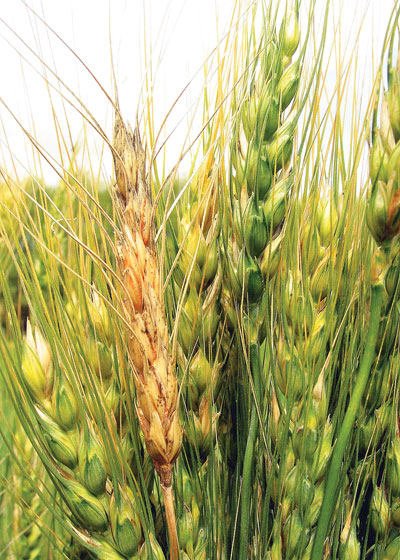
Features
Fungicides
Seed & Chemical
Strategies for management of FHB in cereals
Fusarium head blight (FHB) continues to be one of the most serious diseases affecting cereal crops, especially in the eastern Prairies.
November 21, 2011 By J. Gilbert and A. Tekauz AAFC Winnipeg Manitoba
Fusarium head blight (FHB) continues to be one of the most serious diseases affecting cereal crops, especially in the eastern Prairies. Losses to the Canadian grain industry during the 1990s totalled $200 million for Ontario and Quebec and $300 million for Manitoba. The disease reduces yields and grain quality and the potential contamination of grain by mycotoxins, predominantly deoxynivalenol (DON), is a constant threat to domestic and export markets.
 |
|
| Field symptoms of fusarium head blight on spring wheat. Photos courtesy Andy Tekauz, AAFC. |
Several Fusarium species cause FHB. The predominant species in North America is Fusarium graminearum, especially on wheat. In Manitoba, more than 90 percent of the isolations from Fusarium-damaged kernels are F. graminearum.
The pathogen overwinters in residues at or below the soil surface and produces wind-borne ascospores as the primary inoculum in spring. Inoculum dispersal over many kilometres is possible depending on wind speed and direction.
The random aerial deposition of ascospores increases the importance of local management of FHB via varietal selection (choosing more resistant varieties), fungicide application, tillage and rotation. The provincial seed guides (e.g., Seed Manitoba, 2011) provide information on disease reactions of current varieties. The Canada western hard red spring wheat class (CWRS) has varieties with better resistance to FHB, while Canada prairie spring (CPS) and Canada amber durum wheat (CWAD) are more susceptible. Six-rowed barley varieties are generally more susceptible than two-rowed ones. In oat, while no definite resistance rankings have been developed, a few adapted Canadian varieties of both hulled (e.g. ‘Leggett’) and hulless oats have demonstrated improved resistance. The most susceptible stage of crop growth for infection is heading to soft dough for barley and from flowering to soft dough for wheat.
The disease is strongly influenced by the environment; warm, moist weather when crops are at a susceptible stage, favours disease development. The effects of control strategies traditionally have been examined singly, or at most in twos, but recently, integrated management studies have demonstrated that incremental improvements may be gained by combining multiple strategies.
Varietal resistance
The first line of defence for crop management is varietal selection, which has been shown to be a significant factor for reducing disease incidence, severity, Fusarium-damaged kernels (FDK) and DON accumulation. Success in breeding for resistance to FHB has proven to be elusive as the resistance is multigenic and expression of resistance is dependent on the genetic background of the germplasm.
However, some improvements are apparent in the levels of resistance in recently registered cereals listed in the provincial seed guides.
Rotation
Fusarium graminearum is not host specific and can be isolated from many crop and weed species. Although helpful, rotation alone is not sufficient to prevent disease.
Planting date
Staggered planting dates or sowing several varieties with different heading dates or maturities may help to prevent wholesale infection, but as the weather during flowering cannot be predicted, early or late planting alone is not an assured management option.
Residue management
Crop residues enable the pathogen to overwinter and these can therefore act as a source of inoculum for the following crop. The chopping and spreading of residues may speed their decomposition, which combined with tillage can reduce available inoculum.
Seed treatment
Infested seed can be an additional source of inoculum. Studies show that F. graminearum in or on buried seed may survive for 24 months. However, a dry heat treatment of 70 C for five days was found to be an effective method of eradicating F. graminearum and other Fusarium species from wheat and barley seed. Chemical seed treatments generally improve germination, but efficacy is dependent on temperature and variety.
Foliar fungicide treatments
A foliar fungicide application is recommended in FHB-endemic regions when warm, wet conditions prevail after head emergence and the expected yield return justifies the cost of application. Disease forecasts are available to assist in planning fungicide treatments. Several registered products are currently available (including Caramba, Folicur, Proline, Prosaro) for suppression of the disease.
Integrated management strategies
Recently, a number of studies have reported on the effects of using two or more strategies. The use of rotation and tillage practices on FHB severity and DON accumulation demonstrated that wheat grown after soybeans had a reduced incidence and severity of FHB compared with wheat grown after wheat or maize, regardless of tillage practice. However, the use of a fungicide is probably advantageous. In a winter wheat study, applying a fungicide treatment to a moderately resistant variety at flowering resulted in the lowest FHB and DON levels and the highest yield, while a susceptible variety receiving no fungicide treatment had the highest FHB field severity and DON. The most promising results were in research that demonstrated the incremental benefits of multiple strategies (varietal resistance, rotation and fungicide application) in reducing FHB severity and DON accumulation and simultaneously increasing yields.
The complete, unedited version of this journal article can be found at www.prairiesoilsandcrops.ca .
Prairie Soils and Crops: Scientific Perspectives for Innovative Management is a “peer reviewed” e-Journal that provides agronomists, producers, agrologists and certified crop advisors with current perspectives on various issues pertaining to soil and crop management on the Prairies.